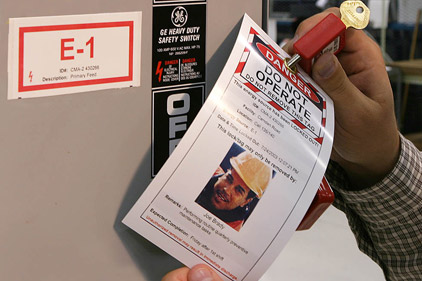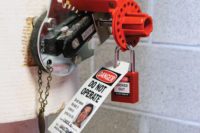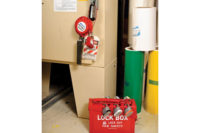1) Failure to develop, document and utilize PROCEDURES.
2) Failure to establish and implement a written PROGRAM.
3) Failure to conduct a PERIODIC INSPECTION of the energy control procedure
4) Failure to provide TRAINING as described by OSHA.
5) Failure to clearly OUTLINE the SCOPE and rules to be utilized, and the means to ENFORCE compliance.
Lockout equipment is important, but it is critical to remember that the devices are only one component of a successful, OSHA-complaint program. Lockout compliance is first and foremost about having a sound program and machine-specific procedures in place. To ensure that your company is complying with OSHA laws and providing a safe work environment for your employees, review these five steps to an effective energy control program.
Step 1: Develop and document your energy control program and policies
According to OSHA’s 29 CFR 1910.147 (c) (1), you need to “establish an energy control policy/program consisting of energy control procedures, employee training and periodic inspections.” A written lockout document should always be your starting point as it establishes the foundation of your overall program.
Step 2: Create and post written, equipment-specific lockout procedures
To meet OSHA standards, “procedures shall be developed, documented and utilized for the control of potentially hazardous energy when employees are engaged in locking out equipment.” Separate procedures must be created and documented for each piece of equipment. Documents should include specific steps for shutting down, isolating, blocking and securing equipment. Other steps should detail placement, removal and transfer procedures for lockout-tagout devices.
Best Practice: Use graphical lockout procedures as they provide employees with photos and clear, visually intuitive instructions that are easy to follow and understand.
Step 3: Identify and mark all energy control points
OSHA and ANSI standards state all energy control points — including valves, switches, breakers and plugs — need to be adequately labeled or marked with permanently placed labels or tags. Cross-reference each label and tag with the corresponding step number in the energy control procedure, and be sure to include information about the control point’s magnitude and purpose.
Tip: If you don’t have the time or resources to make the procedures yourself, comprehensive graphical lockout procedures services are available in which engineers conduct a thorough equipment hazardous assessment, develop necessary equipment-specific procedures and install accompanying energy source location tags throughout your facility.
Step 4: Training, communication and inspection
OSHA requires you to train your employees on lockout-tagout and provide proof that they received the training. Training ensures that the purpose and function of the energy control program is understood by employees.
To comply with OSHA’s standards, establish formal training programs for each of the three employee categories: “Authorized,” “Affected” and “Other.” OSHA provides advice on how to train, and verify that the training is up-to-date.
Tip: Interactive online training courses are one of the easiest ways to accomplish employee lockout-tagout training. Training modules are available for “Authorized” and “Affected” employees, as well as corporate leaders. Many courses feature on-the-spot quizzes and progress tracking for documenting employee certification.
Step 5: Equip your employees with the proper lockout tools and warning devices
Ultimately, the proper application of the lockout hardware makes for a successful program. Having the right tools for the job is important, regardless of your industry. Have the most versatile and sure-fit lockout devices available for employees to assure that lockout procedures meet OSHA requirements.
Lockout devices should be standardized by size, shape or color and the locks used for lockout-tagout should be distinguishable from locks used for other purposes. Devices must also be durable and strong enough to prevent removal, and remain under the exclusive control of the individual who attached them. Tagout devices should be used only if lockout cannot be achieved, and should warn against hazardous conditions if the machine or equipment is energized.
Once you’ve identified the right devices for your facility, document which specific devices are acceptable for use at every lockout point. It will help you communicate more effectively and prevent potential incidents.




